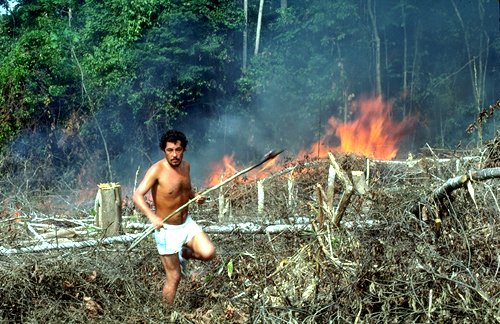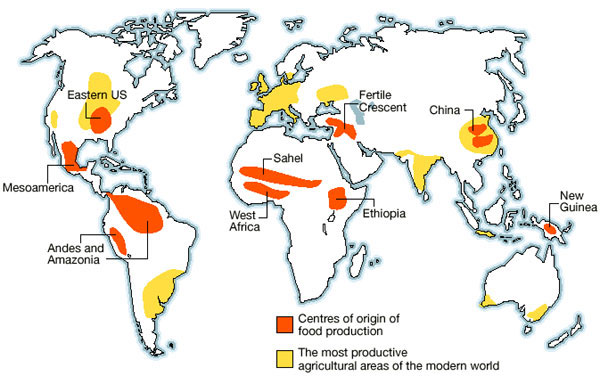
Anth 335 Old World Prehistory
Dr. Darlene Applegate
Spring 2008
Introduction: Food Production Concepts
DETECTING DOMESTICATES IN THE
ARCHAEOLOGICAL RECORD
How do archaeologists distinguish wild and
domesticated species of plants and animals?
DOMESTICATED PLANTS or "CULTIGENS"
- seeds are larger in size
and have thinner seed coats
- plant produces more seeds or more
seed heads
- plant stalk and rachis
(the part of the plant that connects the seed head to the stalk) are
stronger and flexible
- species change from perennials (grow back every year) to annuals (must be replanted every
year)
- pollen has different
overall shape and different surface texture
- species are found outside their
natural range or natural habitat
- changes in genetic or
DNA sequences

 LEFT IMAGE: Flexible rachis in
domesticated barley (left) and brittle rachis in wild barley (right).
LEFT IMAGE: Flexible rachis in
domesticated barley (left) and brittle rachis in wild barley (right).
CENTER/RIGHT IMAGES: Dense seed heads of domesticated sorghum
(center image) compared to limited seed heads of wild sorghum (right
image).
DOMESTICATED ANIMALS
- changes in interior structure of bones
- smaller, more crowded teeth
- sex and age distributions
in skeletal remains at sites (more female individuals and more young
individuals)
- finer hair/wool and
unusual skin/fur pigmentation
- species are found outside their
natural range or natural habitat
- changes in genetic or
DNA sequences

 LEFT IMAGE: Morphological
differences between wild (top) and domesticated (bottom) pigs.
RIGHT IMAGE: Differences
between the skulls of domesticated (top) and wild (bottom) cattle.
LEFT IMAGE: Morphological
differences between wild (top) and domesticated (bottom) pigs.
RIGHT IMAGE: Differences
between the skulls of domesticated (top) and wild (bottom) cattle.
OLD WORLD
HEARTHS
HEARTH is a geographic
location in which domestication and food production were indigenous
developments or “inventions”
there are EIGHT MAJOR HEARTHS
(and many sub-hearths) in the Old World
- the highland zones of the Zagros Mountains (present-day western
Iran) and Anatolian Plateau (present-day central Turkey)
- the "fertile crescent" or river lowlands in portions of
present-day Iraq, Syria, Jordon, and Israel
- southwest Europe
(present-day Greece)
- tropical Africa, including
- Sahara Desert zone (prior to it becoming a desert)
- savanna zone (Sahel) south of the Sahara
- east Africa highland zone
- Indus River valley of
present-day Pakistan and India
Map showing the locations of some Old
World hearths of domestication.
TYPES OF FOOD PRODUCTION
 STOCKBREEDING or HERDING or
PASTORALISM is a subsistence pattern in
which a major
STOCKBREEDING or HERDING or
PASTORALISM is a subsistence pattern in
which a major
part of the diet comes from domesticated animals
 AGRICULTURE or FARMING is
a subsistence pattern in which a major part of the diet comes
AGRICULTURE or FARMING is
a subsistence pattern in which a major part of the diet comes
from
domesticated plants raised by intensive cultivation
 HORTICULTURE or GARDENING
is a subsistence pattern in which a minor
part of the diet comes
HORTICULTURE or GARDENING
is a subsistence pattern in which a minor
part of the diet comes
from domesticated plants raised by nonintensive
cultivation
 SHIFTING AGRICULTURE is
the rotation of crops in fields which are cleared within a forest;
SHIFTING AGRICULTURE is
the rotation of crops in fields which are cleared within a forest;
an
area of forest is cleared, the vegetation is burned, crops are planted
until the soil wears out, and
the plot is left to grow over so the soil
may rejuvenate;
also called swidden, milpa, slash and burn
 FIELD AGRICULTURE is the
cultivation of plants on parcels of land that are used year after year
FIELD AGRICULTURE is the
cultivation of plants on parcels of land that are used year after year
with annual renewal of the soil nutrients by floods or fertilizer
 MONOCROPPING is the heavy
reliance on a single domesticate or few domesticates
MONOCROPPING is the heavy
reliance on a single domesticate or few domesticates
 SUBSISTENCE AGRICULTURE
is growing enough food to fulfill the basic subsistence needs of the
group
SUBSISTENCE AGRICULTURE
is growing enough food to fulfill the basic subsistence needs of the
group
 SURPLUS AGRICULTURE is
growing more food than needed to feed the group, with storage of the
surpluses
SURPLUS AGRICULTURE is
growing more food than needed to feed the group, with storage of the
surpluses
ADVANTAGES
OF FOOD PRODUCTION OVER FOOD COLLECTION
1. food production is more EFFICIENT
in terms of land requirements
- food collection supports about 25 people per 25 square miles
- food production supports about 150 people per 6 square miles
(based on non-mechanized technologies)
2. food production is a more STABLE food source over the course
of a year, if food storage and herds are used
3. food production helps to AVOID UNDERNOURISHMENT
- food producers usually have enough food to eat, especially with
storage of surpluses and herds
4. food production results in increased SPARE TIME during non-planting and
non-harvesting seasons
5. food production allows for greater contributions by OLD AND YOUNG INDIVIDUALS to the
social group
- assist with weeding, stock tending, knowledge of weather patterns
DISADVANTAGES
OF FOOD PRODUCTION COMPARED TO FOOD COLLECTION
1. food production is LABOR
INTENSIVE during planting and harvesting seasons and in clearing
and preparing fields
2. food production is a HIGH
RISK subsistence strategy
- food producers are more susceptible to famine if the crop/herd
fails catastrophically due to insects, diseases, or extreme weather
3. food production often results in MALNOURISHMENT
- food producers who rely on one or few domesticates have a less
varied diet and may lack certain nutrients
4. food production results in decreased SPARE TIME during planting and
harvesting seasons
5. food production results in ENVIRONMENTAL DEGRADATION such as
soil loss, deforestation, and displacment of wild species
6. food production leads to increased VULNERABILITY TO DISEASE
- infectious diseases increase due to sedentism, population
densities, and lack of sanitation
- zoonoses (diseases passed from animals) derive from domesticated
animals kept in herds
- standing water from irrigation systems
- malnourishment can result in or promote diseases related to
nutritional deficiences
- stored crops attract animals (insects, rodents) that carry
diseases
CONSEQUENCES
OF FOOD PRODUCTION
many consequences developed with surplus agriculture (not just
subsistence agriculture)
not all consequences developed in all Old World hearths, nor did they
develop in a particular temporal order in all hearths
some consequences can develop without food production
consequences of food production:
- human alter the environment
rather than adapt to environment
- population increase (in
size and in density)
- new tool technologies
(e.g., grinding stones, plows, sickles, irrigation systems, storage
pits, granaries, corrals)
- social stratification or social
classes
- increase in trade and exchange
- new health and disease
patterns
- monumental public architecture
- complex society ("states"
or "civilizations")
To view the
sources for the images
included on this web page, point to an image and left-click to select
Properties.
The URL for the source of the image is listed under Alternate Text.
Return to Old World Prehistory Home Page
Visit the Western Kentucky University
Home
Page, Western Online
Page composed by Darlene Applegate, darlene.applegate@wku.edu
Last updated on January 28, 2008
All contents copyright (c), 2008. Western
Kentucky
University.



 LEFT IMAGE: Flexible rachis in
domesticated barley (left) and brittle rachis in wild barley (right).
LEFT IMAGE: Flexible rachis in
domesticated barley (left) and brittle rachis in wild barley (right).
 LEFT IMAGE: Morphological
differences between wild (top) and domesticated (bottom) pigs.
LEFT IMAGE: Morphological
differences between wild (top) and domesticated (bottom) pigs.
 STOCKBREEDING or HERDING or
PASTORALISM is a subsistence pattern in
which a major
STOCKBREEDING or HERDING or
PASTORALISM is a subsistence pattern in
which a major  AGRICULTURE or FARMING is
a subsistence pattern in which a major part of the diet comes
AGRICULTURE or FARMING is
a subsistence pattern in which a major part of the diet comes  SHIFTING AGRICULTURE is
the rotation of crops in fields which are cleared within a forest;
SHIFTING AGRICULTURE is
the rotation of crops in fields which are cleared within a forest;  FIELD AGRICULTURE is the
cultivation of plants on parcels of land that are used year after year
FIELD AGRICULTURE is the
cultivation of plants on parcels of land that are used year after year
 MONOCROPPING is the heavy
reliance on a single domesticate or few domesticates
MONOCROPPING is the heavy
reliance on a single domesticate or few domesticates SUBSISTENCE AGRICULTURE
is growing enough food to fulfill the basic subsistence needs of the
group
SUBSISTENCE AGRICULTURE
is growing enough food to fulfill the basic subsistence needs of the
group SURPLUS AGRICULTURE is
growing more food than needed to feed the group, with storage of the
surpluses
SURPLUS AGRICULTURE is
growing more food than needed to feed the group, with storage of the
surpluses